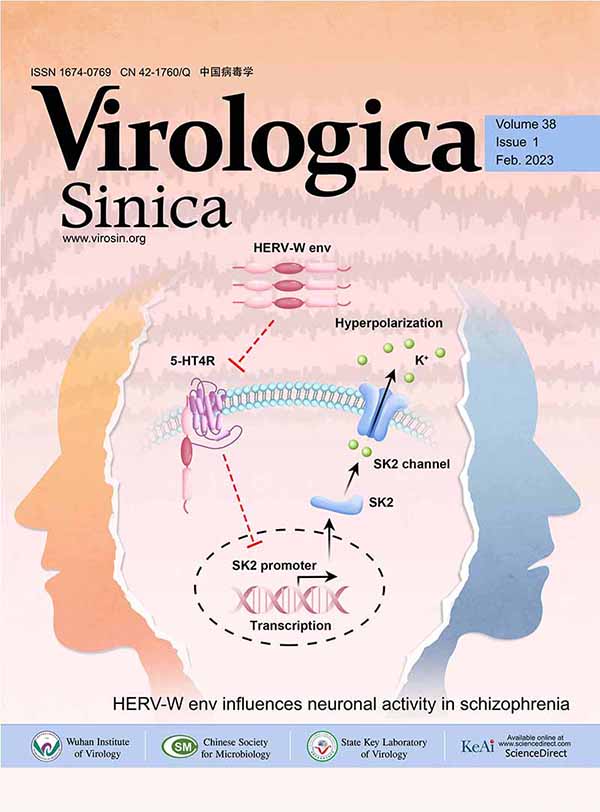HU Quan, LEI Yan-chang, ZHANG Zhen-hua, TIAN Yong-jun, ZHANG Zheng-mao, LI Lei, XIA Jian-bo, LU Meng-ji and YANG Dong-liang. Cloning and Sequence Analysis of Duch Hepatitis B virus Genome from Hubei Brown Ducks[J]. Virologica Sinica, 2006, 21(2): 163-168.
Citation:
HU Quan, LEI Yan-chang, ZHANG Zhen-hua, TIAN Yong-jun, ZHANG Zheng-mao, LI Lei, XIA Jian-bo, LU Meng-ji, YANG Dong-liang.
Cloning and Sequence Analysis of Duch Hepatitis B virus Genome from Hubei Brown Ducks .VIROLOGICA SINICA, 2006, 21(2)
: 163-168.
-
摘要
为了解湖北地区This finding was also confirmed by the phylogenetic tree analysis. 麻鸭中鸭乙型肝炎病毒(Duck hepatitis B virus,DHBV)自然感染状况以及湖北麻鸭所携带DHBV的基因结构特征,采集了70份成年麻鸭血清并应用PCR技术检测DHBV DNA, 对其中一份DHBV DNA阳性血清进行DHBV全基因扩增,并进行克隆与序列测定分析。结果表明,湖北麻鸭DHBV自然携带率为10%;湖北DHBV分离株(GenBank 登录号 DQ276978)基因组的全长为3024bp,有编码P,S和C蛋白的三个开放阅读框;与GenBank中17株DHBV基因组比较,核苷酸同源性介于89.85%~93.29%之间;S蛋白、C蛋白和P蛋白结构功能区序列均高度保守;而对P蛋白标志性氨基酸和全基因进化树的分析表明,该分离株属于DHBV中国基因型中的一个亚型。
Cloning and Sequence Analysis of Duch Hepatitis B virus Genome from Hubei Brown Ducks
-
HU Quan
1
,
-
LEI Yan-chang
1
,
-
ZHANG Zhen-hua
1
,
-
TIAN Yong-jun
,
-
ZHANG Zheng-mao
1
,
-
LI Lei
1
,
-
XIA Jian-bo
1
,
-
LU Meng-ji
2,3
,
-
YANG Dong-liang
1*,,
-
1.
1. Division of Clinical Immunology,Tongji Hospital of Tongji Medical College,Huazhong University of Science and Technology HUST,Wuhan 430030,China
-
2.
Department of Microbiology, Tongji Medical College of HUST, Wuhan 430030,China
-
3.
Institute of Virology,Medical School of Essen University,Essen 45122, Germany
-
Corresponding author:
YANG Dong-liang,
-
-
Abstract
Seventy serum samples were collected from adult brown ducks in Hubei were collected in order to clarify the natural Duck hepatitis B virus (DHBV) infection in and to characterize the genome structure of DHBV. The complete genome of the DHBV strain was amplified by polymerase chain reaction (PCR) and cloned into T vector and sequenced. The results showed that the natural infection rate of DHBV in Hubei was 10%. The DHBV genome isolated by PCR (GenBank accession number DQ276978 ) had 3 024 nucleotides with three overlapping reading frames encoding the surface, core and the polymerase proteins, respectively. Comparison of genome sequences of this strain with those of 17 DHBV strains from the GenBank revealed an identity from 89.3% to 93.5% at the nucleotide level. The amino acid sequences of the S protein,core protein,and functional domain of the Pol protein were highly reserved among all of these DHBV strains. This Hubei strain was found to share more signature amino acids in the polymerase genes with the “Chinese” DHBV strains than those of the “Western” country strains. This finding was also corroborated by a phylogenetic tree analysis. Therefore, this Hubei DHBV strain should be classified to a subtype of the Chinese strains.
-

-
References
-
Proportional views

-
-














 DownLoad:
DownLoad: